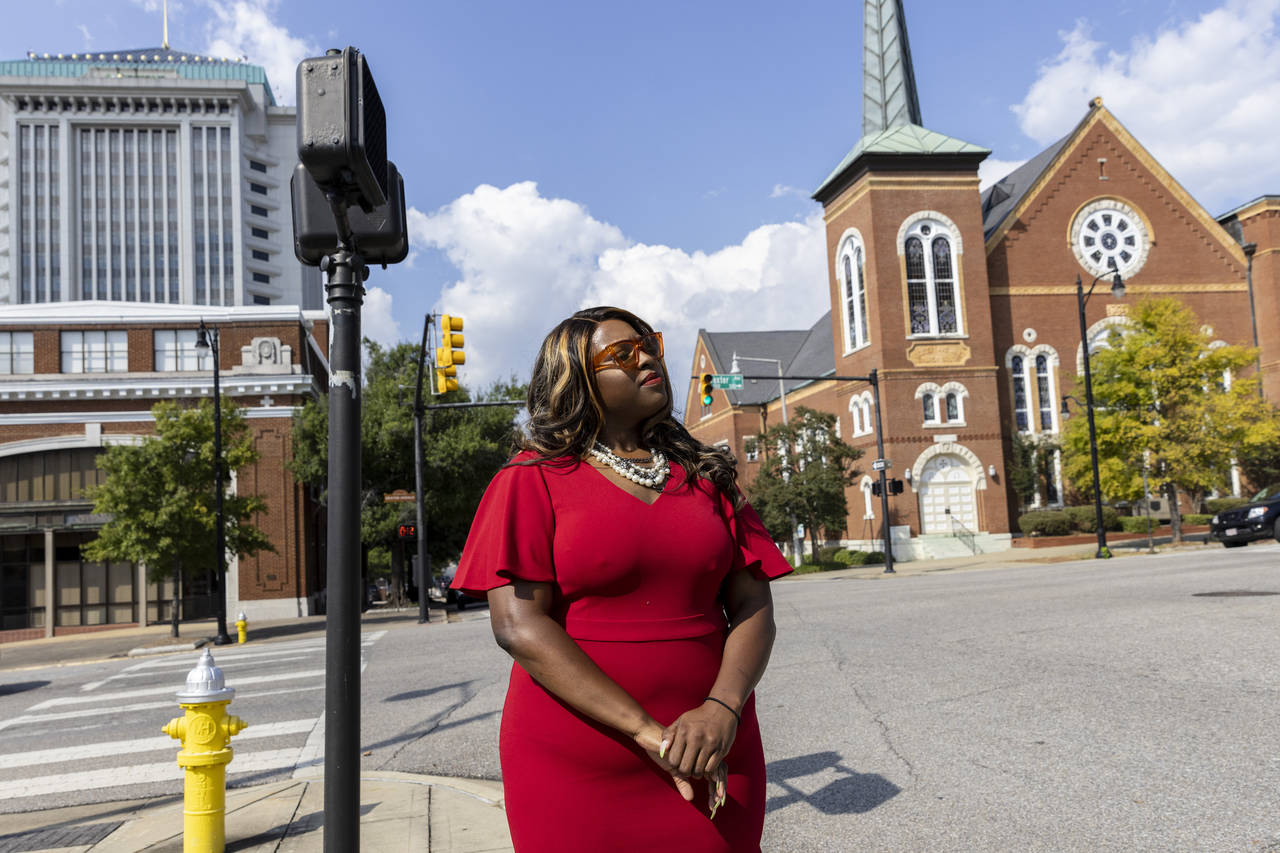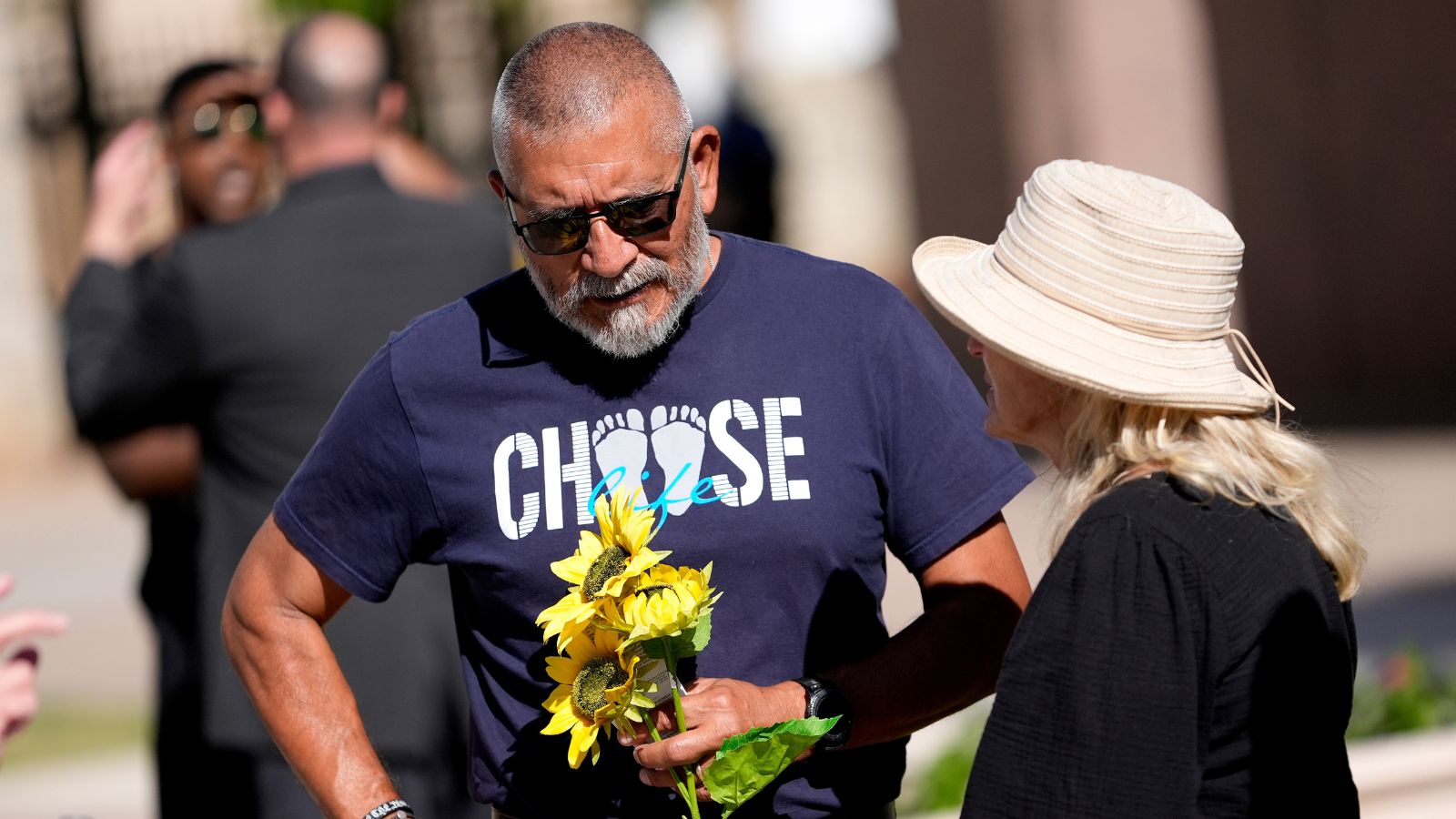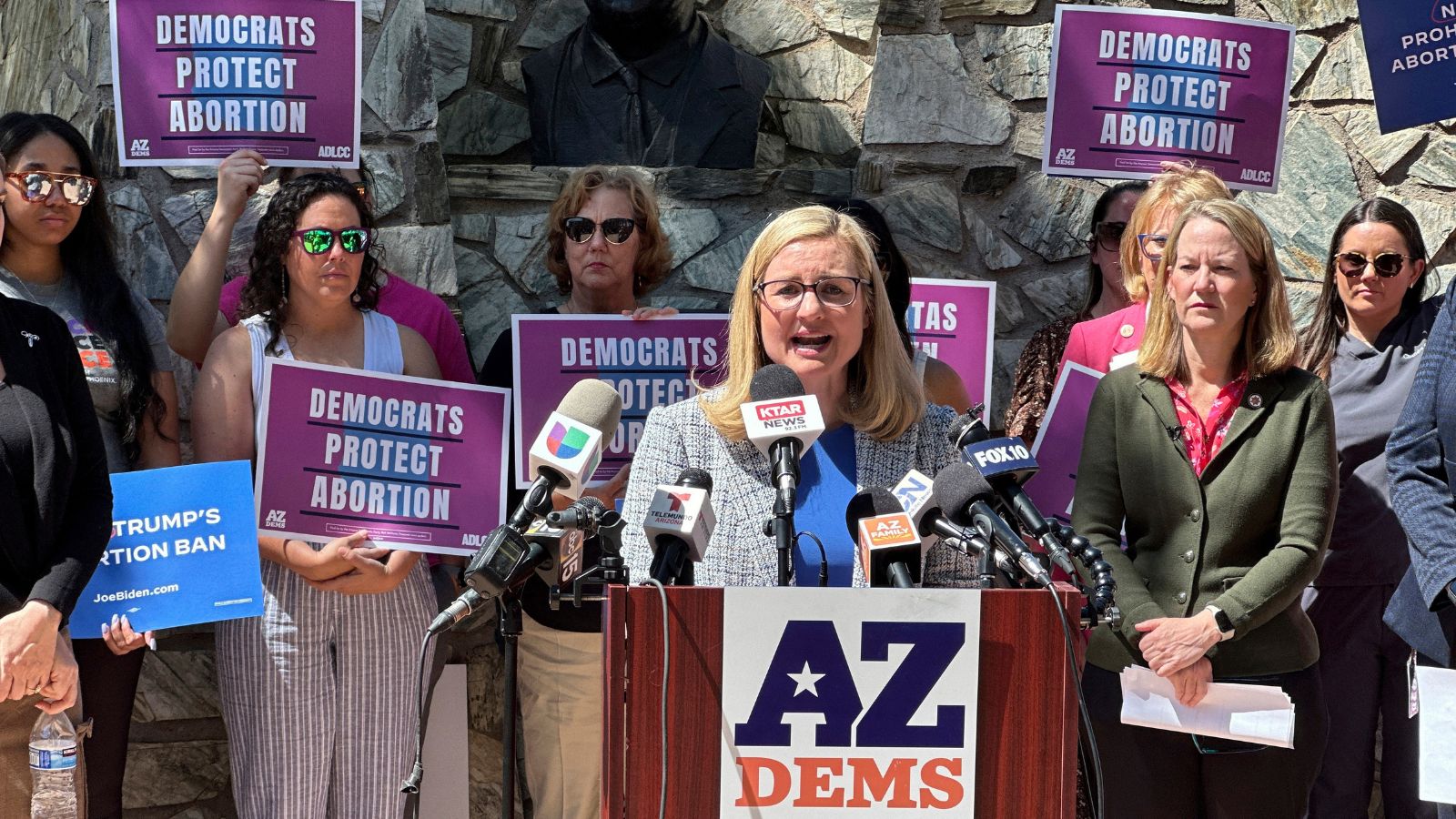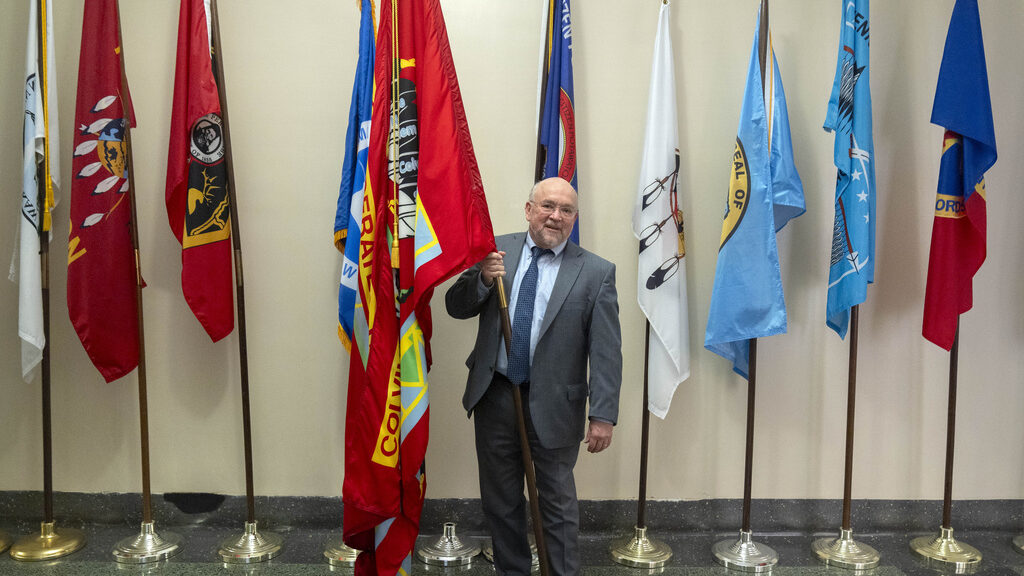Black representation in Alabama tested before Supreme Court
Oct 2, 2022, 9:13 PM | Updated: Oct 3, 2022, 10:33 pm

Khadidah Stone stands on the dividing line between her old Alabama congressional District 7, to her right with River City Church, and her new district, District 2, to her left, in downtown Montgomery, Ala., Tuesday, Sept. 20, 2022. The line splits Montgomery between two congressional districts and is the subject of a high-stakes case that will go before the U.S. Supreme Court on Tuesday. (AP Photo/Vasha Hunt)
(AP Photo/Vasha Hunt)
MONTGOMERY, Ala. (AP) — The invisible line dividing two of Alabama’s congressional districts slices through Montgomery, near iconic sites from the civil rights movement as well as ones more personal to Evan Milligan.
There’s the house where his grandfather loaded people into his station wagon and drove them to their jobs during the Montgomery Bus Boycott as Black residents spurned city buses to protest segregation. It’s the same home where his mother lived as a child, just yards from a whites-only park and zoo she was not allowed to enter.
The spot downtown where Rosa Parks was arrested, igniting the boycott, sits on one side of the dividing line while the church pastored by the Rev. Martin Luther King Jr., who led the protests, sits on the other.
The lines are at the center of a high-stakes redistricting case bearing Milligan’s name that will go before the U.S. Supreme Court on Tuesday, setting up a new test of the Voting Rights Act and the role of race in drawing congressional boundaries.
At the center of the case is a challenge by various groups arguing that the state violated the federal Voting Rights Act by diluting the political power of Black voters when it failed to create a second district in which they make up a majority, or close to it. African Americans account for about 27% of the state’s population but are the majority in just one of the state’s seven congressional districts.
“Our congressional map is not reflective of the population that lives in Alabama,” said Milligan, 41, one of several voters who joined interest groups in filing the lawsuit.
The case the Supreme Court will take up Tuesday centers on whether congressional districts in Alabama were drawn to reduce the political influence of Black voters, but it’s also part of a much broader problem that undermines representative government in the U.S. Both major political parties have practiced gerrymandering — drawing congressional and state legislative boundaries to cement their hold on power — but Republicans have been in control of the process in far more states since after the 2010 elections. That has allowed them to win an outsized share of statehouse and U.S. House seats and means GOP policies — including on abortion restrictions — often don’t reflect the will of most voters.
An Associated Press analysis from 2017 showed that Alabama had one of the most gerrymandered congressional maps in the country.
Republicans dominate elected office in Alabama and are in charge of redistricting. They have been resistant to creating a second district with a Democratic-leaning Black majority that could send another Democrat to Congress.
A three-judge panel that included two appointees of President Donald Trump ruled unanimously in January that the Alabama Legislature likely violated the Voting Rights Act with the map. “Black voters have less opportunity than other Alabamians to elect candidates of their choice to Congress,” the panel said.
The judges ordered state lawmakers to draw new lines for this year’s election and create a second district where Black voters either made up a majority or near majority of the population. But on a 5-4 vote in February, the Supreme Court sided with Alabama to allow this year’s congressional elections to take place without adding a second predominantly Black district. Two justices suggested it was too close to spring primaries to make a change.
The lawsuit claims the Alabama congressional map dilutes the voting strength of Black residents by packing a large number of them into a single district — the 7th, where 55% of voters are Black — while fragmenting other communities. That includes the state’s Black Belt region and the city of Montgomery.
The current districts leave the vast majority of Black voters with no realistic chance to elect their preferred congressional candidates anywhere outside the 7th district, the lawsuit contends.
“This is just about getting Black voters, finally, in Alabama the opportunity to elect their candidates of choice. It’s not necessarily guaranteeing that they will have their candidate elected,” said Deuel Ross, senior counsel at the NAACP Legal Defense and Educational Fund, which is representing the plaintiffs.
The groups contend that the state’s Black population is large enough and geographically compact enough to create a second district. Milligan, who is six generations removed from enslaved ancestors who lived in the Black Belt, ticked off the consequences for Black residents who are not able to have representation that aligns with their needs: addressing generational poverty, the lack of adequate internet service, Medicaid expansion and the desire for a broader array of health care services.
“In choosing not to do that, you’re denying the people of the Black Belt the opportunity to elect an additional person that can really go to the mat on their interests,” said Ross, who is one of the attorneys who will argue the case in a challenge backed by the Biden administration.
___
African Americans served in Alabama’s congressional delegation following the Civil War in the period known as Reconstruction. They did not return until 1993, a year after the courts ordered the state to reconfigure the 7th Congressional District into a majority-Black one, which has since been held by a succession of Black Democrats. That 1992 map remains the basis for the one in use today.
“Under numerous court challenges, the courts have approved this basic plan. All we did is adjust it for population deviation,” said state Rep. Chris Pringle, a Republican and chairman of the legislative committee that drew the new lines.
Alabama argued in court filings that the state’s Black population is too spread out to be able to create a second majority district without abandoning core redistricting principles such as keeping districts compact and keeping communities of interest together. Drawing such a district, the state argued, would require mapping acrobatics, such as connecting coastal areas in southwest Alabama to peanut farms in the east.
In a statement to The Associated Press, Alabama Attorney General Steve Marshall said the map is “based on race-neutral redistricting principles that were approved by a bipartisan group of legislators.” He said it looks similar to three prior maps, including one cleared by the Justice Department and another enacted in the 2000s by “the Democrat-controlled Legislature.”
“The Voting Rights Act does not force states to sort voters based on race,” Marshall said in a statement. “The VRA is meant to prohibit racial gerrymanders, not require them.”
Standing in a meeting room at the Alabama Statehouse and pointing to a poster-size version of the map, Pringle said lawmakers prioritized a race-neutral approach. The lawsuit alleges the Republican lawmakers packed Black voters into certain areas, but Pringle said when they were drawing lines they “turned race off” as an option on the computer. Only later did they apply the racial data points.
“I think the Supreme Court is going to back us up that we complied with existing law,” Pringle said.
___
Alabama’s 7th Congressional District snakes a winding path from the western neighborhoods of Birmingham through the state’s Black Belt — a swath of land named for the rich soil that once gave rise to antebellum plantations — to sections of Montgomery.
Democratic Rep. Terri Sewell, who has represented the district, has been the lone Democrat among the state’s seven House members since she took office in 2011. The state’s other six districts have reliably elected white Republicans for the last decade.
Sewell was the only member of Alabama’s delegation to support restoring the most effective anti-discrimination provision of the Voting Rights Act, which was gutted in a 2013 Supreme Court decision that also arose from an Alabama case. The provision, referred to as preclearance, forced Alabama, other states and some counties with a history of voting discrimination to get Justice Department or federal court approval before making any election-related changes.
Some Black voters outside Sewell’s district say they feel their concerns are overlooked because there is no motivation for Republican officeholders in districts that favor the GOP to pay attention to their issues.
“Fair representation and full representation of the voters in the state of Alabama would mean that a third of the population should get a third of the representation in Congress, and that at least includes one additional seat,” Sewell said. “Look, I think that I would welcome the opportunity to have another seat where I have a colleague that will fight for, you know, voting rights and civil rights, that that will understand that this country has gotten far when it comes to diversity. But we have a long ways to go.”
Alabama’s congressional delegation voted unanimously for the CARES Act, which provided federal aid to state and local governments during the Trump administration as the COVID-19 outbreak was erupting across the country. But that unity vanished when President Joe Biden took office.
Sewell was alone in the delegation in supporting the American Rescue Plan, legislation passed by a Democratic-controlled Congress and signed by Biden. Among other things, she said, the bill benefited community health centers and the health care response at historically Black colleges.
One of them, Alabama State University, was founded two years after the Civil War and in an area where the districts divide. Sewell also was alone in supporting other significant legislation since Biden took office — including the $1 trillion infrastructure bill and the recent Inflation Reduction Act, which, among other provisions, capped out-of-pocket drug costs for Medicare recipients and helped millions of Americans afford health insurance by extending coverage subsidies.
Those types of priorities speak to the Rev. Murphy Green, a local political activist who is supporting the long shot bid by the Democratic candidate in the race for the 2nd Congressional District, where the Republican incumbent won with 65% of the vote two years ago.
He particularly pointed to the health care price controls enacted by Democrats, including for insulin. While diabetes also is a problem for white residents, it is especially systemic among Black people and the cost of drugs to combat it is a priority, Green said in an interview.
“I am a diabetic,” he said. “My congressman voted against price controls on the cost of insulin.”
___
Montgomery, which is split into two congressional districts, is a municipal version of the state when it comes to redistricting.
From customers at a well-known barbershop to shoppers at a convenience store, from groups sitting in empty lots and residents in some of the neighborhoods that are being shifted, the question of who represents them in Congress and who will be on the ballot in November brings a range of answers.
The 2nd Congressional District seat has been held by white Republicans for decades, except for two years when a conservative white Democrat got a bounce from turnout related to Democrat Barack Obama’s presidential campaign in 2008.
Of dozens of people approached, the majority are aware there is an Alabama case going to the Supreme Court, but they don’t know details of the racial gerrymandering behind the case. Some are unaware of who their congressional representative has been.
In Heritage Barber and Style Shop, a local Black barbershop that rides the line between the 2nd and 7th congressional districts and sits across from Alabama State, Stephen Myers, 77, talks about the state’s maps and attempts to minimize Black voting strength.
“What’s different?” he said.
In the decades he has lived in his home, Myers said he has never had the opportunity to cast a “meaningful” vote for a Democrat. Keeping people motivated under those conditions is a challenge, he said.
The operator of a civil rights site tour, Myers said he passed along the significance of voting to his children and grandchildren, but motivating the current generation? “That’s a good question,” he said.
The frustration is shared by the Rev. Benjamin Jones, who heads the St. James Missionary Baptist Church, a congregation of about 300 tucked into the former farmlands of east Montgomery County.
He recalled the sacrifices of older generations during the civil rights movement. His father, for example, would attend protests and marches that sometimes ended with him going to jail, while his mother would stay home so she could bail him out.
“So it is frustrating to know that people went through those type things, but seemingly in 2022 there hasn’t been that much progress in the voting arena in terms of being able to elect people,” he said. “It’s not about someone who shares your same skin tone, but someone who at least cares enough about your politics to be concerned about your issues.”
___
The strategy to challenge a map with a safe majority-Black district comes with risks. As the case goes before the Supreme Court, which has a 6-3 conservative majority, advocates fear an adverse ruling could affect future redistricting cases.
Five conservative justices were in the majority in the February vote blocking the use of the map during this year’s elections. A sixth, Chief Justice John Roberts, objected to the procedure his colleagues used to prevent the districts from being redrawn.
But Roberts has a long history of opposition to the Voting Rights Act and wrote the opinion in the 2013 Supreme Court decision that dismantled part of the law.
The February decision by the court is “a troubling sign of what may be to come,” said Michael Li, senior counsel in the Democracy Center for the Brennan Center for Justice at New York University.
He said there is a real chance the Supreme Court could further gut the Voting Rights Act and “make it all but impossible to use.”
“If the VRA doesn’t apply in the Black Belt of Alabama, it is hard to see it applying in many places,” Li said.
The effects of a decision in favor of Alabama could be widespread, potentially allowing states to dismantle or alter districts that have elected Black, Latino and other minority candidates.
Standing by King’s former church in downtown Montgomery, one of the lawsuit’s plaintiffs acknowledges the risk.
“I am nervous and I’m not afraid to say that,” said 26-year-old Khadidah Stone. “I think the nervous part is looking at what happened in the summer with Roe v. Wade. When I’m looking at that, I look at what else is up to possibly being attacked.”
Even if the plaintiffs prevail, the Alabama Legislature could redraw the lines in a way that actually could jeopardize the one majority Black, Democratic-leaning district. Lowering the percentage of Black voters in Sewell’s district could take an overwhelmingly safe district to one that is less so.
Hank Sanders, a Democrat and former longtime state senator who helped draw the congressional map Alabama put in place 20 years ago, said there is a risk that “you could end up losing both.”
But he said the risks have always been there in pursuing civil and voting rights. That is especially true in Alabama and more specifically Montgomery, where memorials to those advances coexist within sight of statues and memorials honoring the Confederacy.
“If we didn’t take risks and we didn’t take a chance, we’d still be in segregation now,” he said.
___
Sherman reported from Washington. Associated Press data reporter Aaron Kessler contributed to this report.
___
Associated Press coverage of democracy receives support from the William and Flora Hewlett Foundation. The AP is solely responsible for all content.
___
Follow AP for full coverage of the midterms at https://apnews.com/hub/2022-midterm-elections and on Twitter at https://twitter.com/ap_politics
Copyright © The Associated Press. All rights reserved. This material may not be published, broadcast, rewritten or redistributed.



















